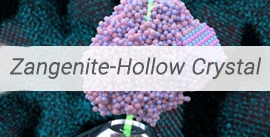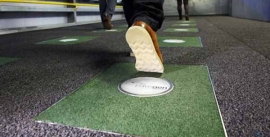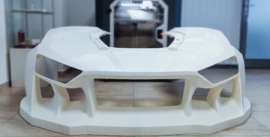 جدید
جدیدشیشه هوشمند (Smart Glass)
شیشه هوشمند smart glass
شیشه هوشمند (اسمارت گلس)
[box type=”shadow” align=”alignright” ] دکتر ژائو می گوید:”اگر ما شیشه ای را با نوعی نانوذره حساس به تابش دمش دهیم و سپس این شیشه ی هیریدی را به صورت فیبر درآوریم، می توانیم حسگر از راه دور مناسب برای تاسیسات هسته ای داشته باشیم.”[/box]
[box type=”success” width=”1024″ ] ترجمه از گروه ترجمه ایران مواد
حرفه ای ترین تیم ترجمه مهندسی مواد کشور
[/box]
محققان استرالیایی در دانشگاه آدلاید روشی برای جاسازی نانوذرات نشردهنده نور درون شیشه بدون افت خواص منحصر به فردشان ایجاد کرده اند که قدمی بزرگ به سمت کاربردهای «شیشه هوشمند» مانند صفحه نمایش های ۳D و یا سنسورهای تشعشع از راه دوراست.
این “شیشه هیبریدی” جدید با موفقیت خواصِ نانوذرات شب تاب مخصوص (یا نشردهنده نور) با جنبه-های شناخته شدهی شیش ، مانند شفافیت و توانایی تبدیل به اشکال مختلف از جمله فیبرهای نوری بسیارریز را با هم ترکیب می کند. این پژوهش با همکاری دانشگاه Macquarie و دانشگاه ملبورن، به صورت آنلاین در مجله مواد پیشرفته نوری Advanced Optical Materials منتشر شده است.
نویسنده ی اصلی تیم ژائو، از موسسه علوم فیزیکی دانشگاه آدلاید و موسسه فوتونیک و سنجش پیشرفته (IPAS) می گوید: “این نانوذرات لومینسانس جدید، نانوذرات upconversion نامیده می شوند، که به گزینه ی مناسبی برای تمامی انواع کاربردهای فوق فن آوری مانند سنجش بیولوژیکی، تصویربرداری پزشکی و صفحه نمایش حجمی۳D تبدیل شده اند.”
گنجاندن این نانوذرات درون اسمارت گلس که معمولا خنثی است، فرصت های هیجان انگیزی را در مورد مواد هیبریدی جدید و بهره برداری از خواص نانوذرات در دستگاه ها به صورتی که قبلا قادر به انجام این کار نبوده ایم را فراهم می کند. به عنوان مثال، دانشمندان علوم اعصاب اکنون از رنگ تزریق شده به مغز و لیزر برای هدایت پیپت شیشه ای به مکان موردنظرشان استفاده می کنند. اگر نانوذرات فلورسنت در پیپت های شیشه ای جاسازی شده بودند، لومینسانس منحصر به فرد شیشه ی هیبریدی می توانست مانند یک مشعل برای هدایت پیپت به طور مستقیم به نورون های تکی موردنظر عمل کند.
هر چند این روش با نانوذرات upconversion توسعه داده شد، پژوهشگران بر این باورند رویکرد جدید آمایش-مستقیم (direct-doping) را می توان به نانوذرات دیگر با خواص فوتونی، الکترونیکی و مغناطیسی شودمند تعمیم داد. کاربردی های بسیاری بسته به خواص نانوذرات پدید خواهد آمد.
دکتر ژائو می گوید:”اگر ما شیشه هوشمند را با نوعی نانوذره حساس به تابش دمش دهیم و سپس این شیشهی هیریدی را به صورت فیبر درآوریم، می توانیم حسگر از راه دور مناسب برای تاسیسات هسته ای داشته باشیم.”
نمایش گرافیکی نانوذرات جاسازی شده در شیشه
تا به امروز، روش مورد استفاده برای گنجاندن نانوذرات upconversion به شیشه بر رشد درجای نانوذرات در داخل شیشه متکی بوده است.
مدیر پروژه پروفسور هایک ابندروف، معاون IPAS اذعان داشت: “ما پیشرفت های قابل توجه ای در این زمینه مشاهده کردیم اما کنترل بر نانوذرات و ترکیبات شیشه ای محدود شده است که این امر منجر به توقف توسعه کاربردهای بسیار درنظرگرفته شده، گردیده است. با روش دوپینگ مستقیم جدید ما، که شامل سنتز نانوذرات و شیشه به طور جداگانه و سپس ترکیب آنها با استفاده از شرایط مناسب است، قادر به حفظ نانو ذرات به صورت سالم و به خوبی پراکنده شده در سراسر اسمارت گلس خواهیم بود. نانوذرات در حال کار باقی می مانند و شفافیت شیشه هم بسیار نزدیک به کیفیت اصلی آن است. ما به سمت دنیای جدیدی از شیشه ی هیبریدی و دستگاه هایی برای فن آوری های برپایه نور، رهسپاریم. “
[box type=”info” align=”alignright” width=”1124″ ]منبع : www.sciencedaily.com
ترجمه : مریم آزاده [/box]
[divider]
Glass now has smart potential
Australian researchers at the University of Adelaide have developed a method for embedding light-emitting nanoparticles into glass without losing any of their unique properties — a major step towards ‘smart glass’ applications such as 3D display screens or remote radiation sensors.
This new “hybrid glass” successfully combines the properties of these special luminescent (or light-emitting) nanoparticles with the well-known aspects of glass, such as transparency and the ability to be processed into various shapes including very fine optical fibres.
The research, in collaboration with Macquarie University and University of Melbourne, has been published online in the journal Advanced Optical Materials.
“These novel luminescent nanoparticles, called upconversion nanoparticles, have become promising candidates for a whole variety of ultra-high tech applications such as biological sensing, biomedical imaging and 3D volumetric displays,” says lead author Dr Tim Zhao, from the University of Adelaide’s School of Physical Sciences and Institute for Photonics and Advanced Sensing (IPAS).
“Integrating these nanoparticles into glass, which is usually inert, opens up exciting possibilities for new hybrid materials and devices that can take advantage of the properties of nanoparticles in ways we haven’t been able to do before. For example, neuroscientists currently use dye injected into the brain and lasers to be able to guide a glass pipette to the site they are interested in. If fluorescent nanoparticles were embedded in the glass pipettes, the unique luminescence of the hybrid glass could act like a torch to guide the pipette directly to the individual neurons of interest.”
Although this method was developed with upconversion nanoparticles, the researchers believe their new ‘direct-doping’ approach can be generalised to other nanoparticles with interesting photonic, electronic and magnetic properties. There will be many applications — depending on the properties of the nanoparticle.
“If we infuse glass with a nanoparticle that is sensitive to radiation and then draw that hybrid glass into a fibre, we could have a remote sensor suitable for nuclear facilities,” says Dr Zhao.
To date, the method used to integrate upconversion nanoparticles into glass has relied on the in-situ growth of the nanoparticles within the glass.
“We’ve seen remarkable progress in this area but the control over the nanoparticles and the glass compositions has been limited, restricting the development of many proposed applications,” says project leader Professor Heike Ebendorff-Heideprem, Deputy Director of IPAS.
“With our new direct doping method, which involves synthesizing the nanoparticles and glass separately and then combining them using the right conditions, we’ve been able to keep the nanoparticles intact and well dispersed throughout the glass. The nanoparticles remain functional and the glass transparency is still very close to its original quality. We are heading towards a whole new world of hybrid glass and devices for light-based technologies.”










دیدگاه کاربران